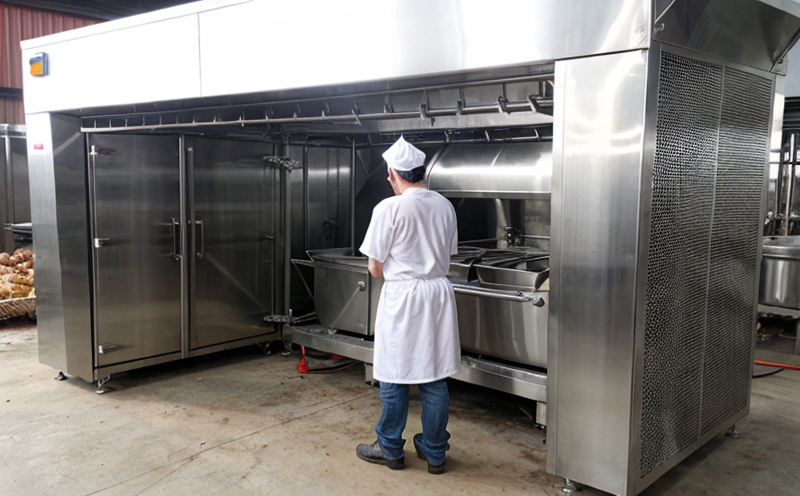Food cooling process inspection
The food cooling process is a critical step in ensuring food safety and hygiene. Proper cooling of products not only enhances product quality but also prevents the growth of harmful pathogens that can cause foodborne illnesses. This service ensures that the cooling process adheres to strict temperature guidelines, thereby safeguarding public health.
In the context of food safety and hygiene inspection, a well-executed cooling process is essential for maintaining the integrity of perishable products like meat, poultry, fish, dairy, and other vulnerable foods. The aim is to cool these items rapidly from high temperatures down to safe storage levels within a specified time frame.
Temperature control during the cooling phase is vital because it directly impacts the microbial activity in food products. According to ISO 15216-1:2018, Rapid chilling of meat and poultry should be achieved at rates that reduce core temperatures by at least 12°C within a set time frame. This standard underscores the importance of efficient cooling processes to prevent pathogen proliferation.
Failure to achieve adequate cooling can lead to cross-contamination and increased risk of spoilage, which could result in significant economic losses for manufacturers and serious health risks for consumers. The inspection process involves several key parameters that must be meticulously monitored:
- Initial Temperature: This is the temperature at which cooling begins.
- Cooling Rate: The rate at which the product's core temperature decreases during the chilling process. It should not exceed specified limits to prevent bacterial growth.
- Core Temperature: This refers to the internal temperature of the food item, which is critical for assessing whether it has been adequately cooled.
- Final Temperature: The target temperature at which cooling ends, typically around 5°C or lower.
The inspection process also includes a series of steps that ensure compliance with these parameters:
- Sampling and preparation of the food item for testing.
- Monitoring and recording of temperature changes over time using advanced instrumentation like thermocouples or infrared sensors.
- Analyzing collected data to determine if the cooling process meets set criteria.
- Generating detailed reports that document all aspects of the inspection, including any deviations from standard operating procedures.
The use of such rigorous methods ensures not only compliance with international standards like ISO 15216-1 but also enhances consumer trust and regulatory satisfaction. By focusing on these critical factors, our service aims to deliver a comprehensive assessment that guarantees the safety and quality of food products throughout their lifecycle.
Why It Matters
The significance of proper cooling cannot be overstated in the context of food safety and hygiene inspection. Ensuring that foods are cooled appropriately is not just about maintaining product quality; it’s a matter of public health. Rapid and effective cooling prevents the growth of pathogens, reduces the risk of cross-contamination, and extends shelf life, which ultimately benefits both manufacturers and consumers.
Inadequate cooling can lead to several adverse outcomes:
- Pathogen proliferation: Bacteria such as Salmonella, Listeria, and E. coli thrive in warm environments, making proper cooling essential for their elimination or control.
- Cross-contamination: Improper cooling can cause cross-contamination between different food products, leading to spoilage and potential health hazards.
- Product quality degradation: Excessive heat retention during the cooling process can negatively affect texture, flavor, and nutritional value of foods.
- Economic losses: Spoiled or contaminated products result in significant economic losses for manufacturers and retailers. Efficient cooling processes help minimize these costs by ensuring product integrity.
Given these implications, the implementation of robust inspection methods is crucial. Our services are designed to provide assurance that food products are being cooled according to best practices, thereby contributing to safer consumption and a healthier population.
Applied Standards
The food cooling process inspection aligns closely with several international standards aimed at ensuring safe and hygienic food handling. These include:
- ISO 15216-1:2018: This standard specifies the chilling, freezing, and thawing of meat and poultry products to ensure rapid reduction in core temperature.
- ASTM D7943-14: Provides guidelines for the testing of refrigeration equipment used in food cooling processes.
- EN 25026:2018: Offers criteria for the design and operation of chilling rooms for meat products to ensure efficient cooling rates.
- IEC 62439-2:2017: Focuses on power supply systems used in refrigeration units, ensuring reliability during critical cooling operations.
The application of these standards ensures that the cooling process is not only effective but also consistent with global best practices. Compliance with such standards is essential for maintaining high-quality food products and adhering to regulatory requirements.
Use Cases and Application Examples
The use cases for our food cooling process inspection service are broad and varied, catering to different sectors within the food industry:
- Poultry Processing Plants: Ensuring that poultry products are cooled rapidly after processing to prevent bacterial growth.
- Meat Slaughterhouses: Monitoring the chilling process of fresh meat to maintain quality and safety standards.
- Dairy Farms: Checking the cooling of milk and dairy products to avoid spoilage and ensure consistent quality.
- Fish Processing Facilities: Guaranteeing that fish products are cooled at optimal rates to preserve freshness and nutritional content.
- Convenience Food Manufacturers: Verifying rapid chilling processes for packaged meals and ready-to-eat snacks.
- Restaurant Chains: Auditing the cooling of perishable ingredients used in food preparation to prevent contamination.
- E-commerce Platforms: Ensuring that cold chain logistics are maintained during the delivery of frozen or chilled foods.
In each case, our service provides detailed reports and recommendations tailored to the specific needs of the client. This ensures that all stakeholders involved in the food supply chain can rely on consistent quality and safety standards.





